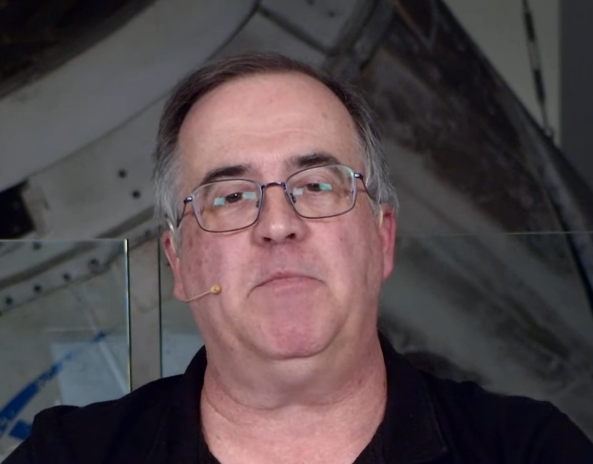

Plus the occasional ULA sniper wielding the SpaceXpelliarmus spell.


Plus the occasional ULA sniper wielding the SpaceXpelliarmus spell.


A landing leg failure, for example, likely could be quickly cleared because it is not used in other phases of flight
I assume SpaceX wouldn’t make any big assumptions along these lines though?
I imagine, for example, that a worn component that could fail catastrophically on landing might also be at risk of some kind of failure during max Q, in a way that affects the primary mission.
Of course, there could come a point where you judge that so unlikely as to be not worth wasting any (further) time on.
But as an armchair observer I’m fairly glad to see a pause at this point before Polaris Dawn, even just a couple of days …
“We’re just focused on recovery weather at this point,” he said after the announcement of the FAA investigation into the booster landing anomaly. “I think that is still gate to our launch.”
Surprising. Does this mean they have good reason to think they’ll get a Public Safety Determination in a matter of days? Does the FAA work weekends?
P.S. If a landing leg realistically could, say, pop open at max Q, I guess that further strengthens the argument in favour of rocket ‘catchings’ rather than rocket landings!


the company will likely need to redesign some elements in the spacecraft’s propulsion system to remedy the problems
I expect they’ll make a change to whatever is responsible for the helium leaks. But as for keeping the thrusters healthy, Steve Stich keeps talking about software/operational changes as a way to accomplish that, so we might not see much of a redesign (at least in the short/medium term).
Had the Starliner test flight ended as expected, with its crew inside, NASA targeted no earlier than August 2025 for Boeing to launch the first of its six operational crew rotation missions to the space station. In light of Saturday’s decision, there’s a high probability Starliner won’t fly with astronauts again until at least 2026.
Wasn’t it actually February 2025? With the delay to August 2025 only announced very recently, as a result of all these CFT problems?
And that might be all the extra time Boeing needs. Especially considering my previous point.
originally planned for an eight-day stay at the station
Well, yes, as a bare minimum.
the owners of a private space station will almost certainly go with the less expensive, flight-proven vehicle to transport people to and from orbit.
Will it be their decision, when the people being transported are NASA astronauts? I could easily see NASA wanting to continue their ‘dissimilar redundancy’ policy indefinitely.


Me too. I had thought we were talking about a 1% chance or something like that.
But at the press conference, one of the journalists seemed to be asking about the probability of disaster, and gave 10% as an example. None of the NASA people took the opportunity to say “no that’s far too high”, or “I’m very confident the uncrewed return of Starliner will be successful”, or anything like that.


I’ve been wondering why there’s such a big gap between Starliner’s expected departure (“early September”) and the launch of Crew-9 (no earlier than 2024-09-24).
My least bad guess is that NASA doesn’t see much difference in the risk of having Butch & Suni return as (little more than) cargo inside Crew-8’s Dragon capsule, and the risk of them returning in the actual standard/proper crew configuration in this Starliner capsule. In which case they might as well get Starliner back ASAP, while making no attempt to bring the Crew-9 date forward (which could have been doable given that the plan as of last month was to be ready by 2024-08-18).
Has anyone got a better guess?
I do know that a standard Starliner departure involves waiting for a suitable opportunity / time window. But there must be suitable opportunities much closer to the 24th, right? Why aren’t they waiting for the last possible (or maybe penultimate) opportunity? In the unlikely event of Starliner failing to undock or whatever, it’d be no big deal to delay Crew-9 again, so I don’t think that would be the reason.
I had been imagining a much greater level of dependency or ‘coupling’ between the two events. Perhaps with NASA looking at the Crew-9 launch weather forecasts before deciding whether to undock Starliner about 3 days earlier, or something. Or even (less seriously), the Crew-9 crew strapped into their Dragon, on the launchpad, and hearing on their comms system something like “Starliner has successfully exited the ISS’s Keep Out Sphere, so NASA is ‘go’ for propellant load on Falcon 9”.
I was hoping somebody would ask this question during the press conference, but they didn’t.


the host says they’re going to higher altitudes than the Apollo program
Ah, yes, well normally that would be my opportunity to remind people of Gell-Mann amnesia.
But this time it’s unfair to the host. Isaacman has made that mistake himself on (I think) multiple occasions. She might have got it from him. (Perhaps indirectly.) Here’s one: https://youtu.be/aASZ2rKdS6I?t=1m2s (He meant “since”, not “than”.)
One source of confusion might be if this crew is planning to be in the highest ‘free’ orbit of Earth ever occupied by humans. Where I’m using ‘free’ as a vague way of trying to exclude, for example, the astronauts who were actually on the moon (which is of course orbiting the Earth).
Is that a scientifically/technically legitimate & meaningful distinction? If so, is there a better term for it?


the host says they’re going to higher altitudes than the Apollo program
Ah, yes, well normally that would be my opportunity to remind people of Gell-Mann amnesia.
But this time it’s unfair to the host. Isaacman has made that mistake himself on (I think) multiple occasions. She might have got it from him. (Perhaps indirectly.) Here’s one: https://youtu.be/aASZ2rKdS6I?t=1m2s (He meant “since”, not “than”.)
this one doesn’t really have anything that makes it fundamentally unsafe.
You’re probably right, but we’ll see. The altitude and the spacewalk are the first big new initiatives for SpaceX’s human spaceflight work that haven’t been done under close NASA supervision. That’s probably a good thing but … I’m nervous.
Talking of the altitude, this is from the article:
The mission is scheduled to launch between 3:30 and 7 a.m. Eastern Aug. 26 in one of three instantaneous launch windows. Isaacman said the launch times were selected by SpaceX to minimize the micrometeoroid and orbital debris impact risk to the mission given its unconventional orbit.
He said it during the event (which is available to watch here), and I don’t think any further explanation was given for why certain launch times are better than others for MMOD. Does anyone understand why? Is it obvious? Any resources I could check out to learn more?
Talking of the article, they still haven’t fixed the first sentence!:
spacewalk on a is ready
If Jeff or anyone else from Space News is reading this, hire me as your proofreader!


Interesting title on the video about this, just uploaded to YT by CBS News: SpaceX sending private citizens on risky mission that includes spacewalk attempt
I find myself agreeing with the sentiment. I’m fairly nervous about this mission.
Don’t get me wrong, I’d jump at the chance to join it. I’d choose it over a routine trip on Starliner, but not for the reason you might be thinking. … I can’t help wondering if Polaris Dawn is both higher risk and reward than a routine trip on Starliner.


No, that’s this one, funded by a crypto billionaire, announced a week ago and launching in ~4 months.
Polaris Dawn is funded by a payments processing billionaire, announced 2.5 years ago, and launching this month.


That has to be a requirement regardless I guess since a depressurization could happen on any flight.
Yes, this has been pointed out by the crew (IIRC) in an interview about the mission. (Not to suggest that no work was needed on the issue, just less work than people might expect. Obviously it can be the case that taking an unlikely contingency scenario and making it a deliberate part of a mission, raises the level of assurance needed.)


Well, consider various lesser versions of Scenario 1. What if the crew was only partially reduced in their capabilities?
Perhaps they were both suffering from the symptoms of carbon monoxide poisoning (including headaches, dizziness, and confusion). Or perhaps one was serously injured, and the other was fine but needed to focus all her attention on tending to her crewmate?
Then it would come down to the question of just how complex and time-consuming the required manual step(s) are. If there’s just a big red button that says “TAKE US HOME” then, it shouldn’t be a problem. But we don’t know.
And if there was just a big red button, couldn’t they try bypassing the current 4-week delay, by coming up with some ways of pressing it without humans on board? ;) Shove an astrobee in there and give it a try. If it doesn’t work, no harm done …


Aren’t there several realistic scenarios …
Emergency on board ISS. 1) One aspect of the emergency (e.g. noxious air) has incapacitated many of the crew, including all the ones trained to operate Starliner. 2) Another aspect of the problem (e.g. electrical faults that are expected to lead to fire) leaves no doubt that evacuation is essential.
Those ISS crew who managed to don emergency breathing apparatus quickly enough now move the incapacitated Starliner crew to their seats, strap them in and exit Starliner (closing the hatches on their way out), before proceeding to their own vehicle(s).
Serious MMOD strike upon a docked vehicle, causing damage that makes it very unlikely to be safe for its crew to return in, and also at significant risk of posing a danger to the ISS.
Wouldn’t the least bad option be to command an uncrewed undocking and hope for the best?
During a flight test, a spacecraft is able to dock with ISS, but only after encountering significant problems. The first job of engineers is to consider whether it is sufficiently safe for the crew to return to Earth in, in the event of an emergency. Their decision is either ‘no’, or ‘barely’.
An alternative provider of crewed LEO access services, known for its proficiency and speed of operations, announces that they will be able ready to send a replacement vehicle by the time of a suitable launch opportunity in 4 days’ time.
There are no spare docking ports.


In the implication here that it is Congress who want a diversity of suppliers, whereas NASA doesn’t care as much?
Yes, I think that’s the implication. I realized it’s not correct but decided to leave it like that. I’m a big picture kinda guy; someone else can sort out the details!
I guess it might be more like a combined NASA / Space Force high level strategic fund providing the subsidy. So that individual ‘low level’ programmes within NASA / Space Force then don’t have to worry too much about the long term strategic goals like dissimilar redundancy, and can mostly just focus on their own needs.


If NASA decides to send Starliner back empty, it’s a vote of no confidence in Boeing that may lead the company to cut its losses and withdraw from the program.
How would this work, contractually? Would they have to give back the whole $4.1 billion (or whatever)? And pay penalties on top to cover NASA’s costs?


the most likely alternative would be to bring the astronauts back using SpaceX’s Crew Dragon by removing two astronauts from the Crew-9 mission
The most likely? Not convinced. Wouldn’t anyone removed from Crew-9 just be shifted to Crew-10? So it’d seem silly to announce Crew-10 only to have to change it a week later.
And even if they don’t care about looking silly in that way, they might instead just go with one empty seat ‘uphill’ for each of Crew 9 and 10. Because that’s a less drastic change to make to Crew 9 at such short notice.
But maybe I’m wrong. So, assuming the quoted scenario actually is what happens …
I guess they’d have to keep the Russian (Gorbunov)?
And keep the capsule commander (Cardman)? But she’s never been to space, so maybe the pilot (Hague)? I can’t immediately see if he was expected to be the ISS commander, but if so, I guess that would give them a good excuse to ‘promote’ him over Cardman?
Wilson has had more launches than Hague (3 versus 2ish) but a lot less time in space, and I don’t know if she would be as well trained for Dragon as the commander & pilot.


They say they really like Starliner, and I think they mean it. After all, it’s not that bad! If you offered me a free trip to space in it, I’d jump at the chance.
In fact I’d offer to pay at least 1/3 of my net worth. (Sadly this doesn’t quite equate to the current cost-per-astronaut of, what, $150m?)


Turns out that some of the later parts of the video I posted largely negated my above comment.
What do you think will happen to the other one? Do you think they’ll maintain a Florida splashdown capability indefinitely, as a backup
Question at 43:08.
43:56 “There may be a small transition period as we’re moving vessels through the Panama Canal … where we can support either Coast …” (implying not indefinite)
e.g. in case of bad weather in all the new West Coast splashdown zones
51:15 “one benefit of moving to the West Coast is much better weather”
Also of interest …
30:39. Sounds like they didn’t bother with a Public Safety Determination in the end, and just went directly to full(?) approval.


And I see that the Soyuz TMA-11 crew included Peggy Whitson. We wouldn’t want the same kind of thing to happen to her twice!
(Her 2nd Axiom mission is NET November this year, so that shouldn’t be affected by this change, but any subsequent Axiom missions might be.)


Only yesterday I was here objecting to large expenditures on debris mitigation (specifically, to the “US De-Orbit Vehicle” for the ISS), so I guess I’d better be consistent (regardless of down-votes)!
If I was advising SpaceX, I’d tell them to go with this West Coast plan.
If I was advising humanity as a whole, I’d point out that despite our evolved psychology as a species, we are sometimes still capable of behaving rationally. And if the expected value of any particular iniative to make some space industry debris less likely to do harm to people/property is less than the actual cost of that initiative, it probably shouldn’t go ahead.
Also, I’d be interested to see how this changes the Loss of Crew probability. Presumably it’s less risky to do trunk separation prior to the deorbit burn, because if the separation process encounters any problems, there is much more of an opportunity for troubleshooting.
Damn, they should’ve collab’ed with the Marshall Mathers Space Flight Center, like I been sayin
(I sent two letters back in autumn, JAXA must not’ve got 'em. There prob’ly was a problem at the post office or somethin)